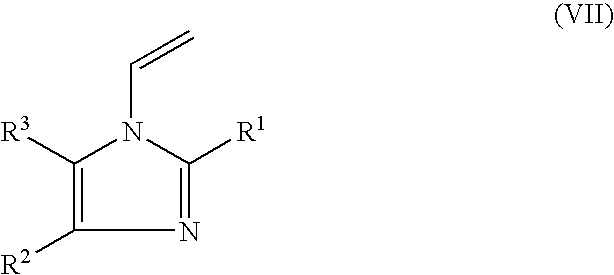Cosmetically used cross-linked methyl methacrylate-copolymer
a technology of methyl methacrylate and methyl methacrylate, which is applied in the field of cosmetics and synthetic polymer active ingredients, can solve the problems of inadequate setting effect, poor hold of hair, and lack of mechanical quality
- Summary
- Abstract
- Description
- Claims
- Application Information
AI Technical Summary
Benefits of technology
Problems solved by technology
Method used
Image
Examples
preparation example 1
[0445]The following feeds were prepared with stirring at 20° C.:
Feed 1111 gMMA22.5 g MAA 15 gAA100 gEthanolFeed 2 1.5 gWako ® V 59 50 gEthanol
[0446]At 20° C., a mixture of 150 g of ethanol, 15% by weight of the total amount of feed 1, and 15% by weight of the total amount of feed 2 was prepared. The mixture was heated to 78° C. under atmospheric pressure. While retaining the polymerization temperature, after 78° C. had been reached, feed 1 and feed 2 were started. Feed 1 was metered in over the course of 3 h, and feed 2 was metered in over the course of 4 h with constant feed stream. When feed 2 was complete, the reaction mixture was kept at 78° C. for a further 2 h and then cooled to room temperature (ca. 20° C.).
preparation example 2
[0447]The following feeds were prepared with stirring at 20° C.:
Feed 1 114 gMMA 23 gMAA15.4 gAA1.54 gLaromer ® TPGDA 100 gEthanolFeed 22.25 gWako ® V 59 50 gEthanol
[0448]At 20° C., a mixture of 150 g of ethanol, 15% by weight of the total amount of feed 1, and 15% by weight of the total amount of feed 2 was prepared. The mixture was heated to 78° C. under atmospheric pressure. While retaining the polymerization temperature, after 78° C. had been reached, feed 1 and feed 2 were started. Feed 1 was metered in over the course of 3 h, and feed 2 was metered in over the course of 4 h with constant feed stream. When feed 2 was complete, the reaction mixture was kept for a further 2 h at 78° C. and then cooled to room temperature (ca. 20° C.).
preparation example 3
[0449]The following feeds were prepared with stirring at 20° C.:
Feed 1120 gMMA 15 gMAA 15 gAA175 gEthanolFeed 2 3 gSodium peroxodisulfate 75 gWater
[0450]At 20° C., a mixture of 100 g of ethanol, 15% by weight of the total amount of feed 1, and 15% by weight of the total amount of feed 2 was prepared. The mixture was heated to 78° C. under atmospheric pressure. While retaining the polymerization temperature, after 78° C. had been reached, feed 1 and feed 2 were started. Feed 1 was metered in over the course of 3 h, and feed 2 was metered in over the course of 4 h with constant feed stream. When feed 2 was complete, the reaction mixture was kept for a further 2 h at 78° C. and then cooled to room temperature (ca. 20° C.).
PUM
| Property | Measurement | Unit |
|---|---|---|
| Percent by mass | aaaaa | aaaaa |
| Percent by mass | aaaaa | aaaaa |
| Percent by mass | aaaaa | aaaaa |
Abstract
Description
Claims
Application Information
 Login to View More
Login to View More - R&D
- Intellectual Property
- Life Sciences
- Materials
- Tech Scout
- Unparalleled Data Quality
- Higher Quality Content
- 60% Fewer Hallucinations
Browse by: Latest US Patents, China's latest patents, Technical Efficacy Thesaurus, Application Domain, Technology Topic, Popular Technical Reports.
© 2025 PatSnap. All rights reserved.Legal|Privacy policy|Modern Slavery Act Transparency Statement|Sitemap|About US| Contact US: help@patsnap.com



